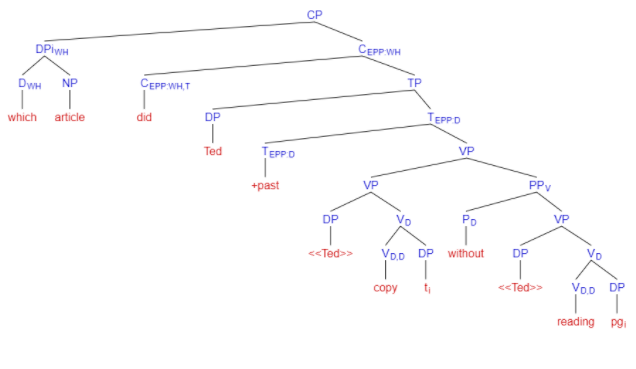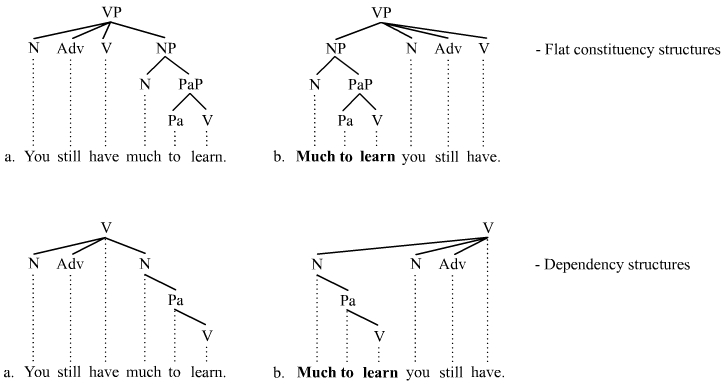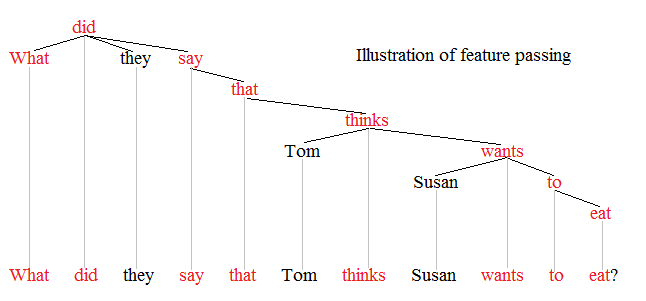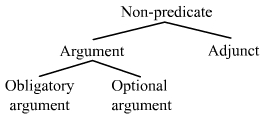|
Parasitic Gap
In generative grammar, a parasitic gap is a construction in which one gap appears to be dependent on another gap. Thus, the one gap can appear only by virtue of the appearance of the other gap, hence the former is said to be "parasitic" on the latter. For example, in the example sentence in (1) the first gap is represented by an underscore ( __ ), and appears as a result of movement of the constituent ''which explanation'' to the beginning of the sentence. The second gap is represented by an underscore with a subscript p ( __p); this is the "parasitic gap". : While parasitic gaps are present in English and some related Germanic languages, e.g. Swedish (see Engdahl 1983), their appearance is much more restricted in other, closely related languages, e.g. German and the Romance languages. Japanese linguistic scholar Fumikazu Niinuma has attempted to differentiate between parasitic gaps and coordination in his research, as he believes the two are often confused. An aspect of parasitic ... [...More Info...] [...Related Items...] OR: [Wikipedia] [Google] [Baidu] |
Generative Grammar
Generative grammar, or generativism , is a linguistic theory that regards linguistics as the study of a hypothesised innate grammatical structure. It is a biological or biologistic modification of earlier structuralist theories of linguistics, deriving ultimately from glossematics. Generative grammar considers grammar as a system of rules that generates exactly those combinations of words that form grammatical sentences in a given language. It is a system of explicit rules that may apply repeatedly to generate an indefinite number of sentences which can be as long as one wants them to be. The difference from structural and functional models is that the object is base-generated within the verb phrase in generative grammar. This purportedly cognitive structure is thought of as being a part of a universal grammar, a syntactic structure which is caused by a genetic mutation in humans. Generativists have created numerous theories to make the NP VP (NP) analysis work in natural la ... [...More Info...] [...Related Items...] OR: [Wikipedia] [Google] [Baidu] |
Object-raising
In linguistics, raising constructions involve the movement of an argument from an embedded or subordinate clause to a matrix or main clause; in other words, a raising predicate/verb appears with a syntactic argument that is not its semantic argument, but is rather the semantic argument of an embedded predicate. For example, in ''they seem to be trying'', the predicand of ''trying'' is the subject of ''seem''. Although English has raising constructions, not all languages do. The term ''raising'' has its origins in the transformational analysis of such constructions; the constituent in question is seen as being "raised" from its initial deep structure position, as the subject of the embedded predicate, to its surface structure position in the matrix predicate/verb. Raising predicates/verbs are related to control predicates, although there are important differences between the two predicate/verb types. Examples There are at least two types of raising predicates/verbs: raising-to-s ... [...More Info...] [...Related Items...] OR: [Wikipedia] [Google] [Baidu] |
Generative Syntax
Generative grammar, or generativism , is a linguistic theory that regards linguistics as the study of a hypothesised innate grammatical structure. It is a biological or biologistic modification of earlier structuralist theories of linguistics, deriving ultimately from glossematics. Generative grammar considers grammar as a system of rules that generates exactly those combinations of words that form grammatical sentences in a given language. It is a system of explicit rules that may apply repeatedly to generate an indefinite number of sentences which can be as long as one wants them to be. The difference from structural and functional models is that the object is base-generated within the verb phrase in generative grammar. This purportedly cognitive structure is thought of as being a part of a universal grammar, a syntactic structure which is caused by a genetic mutation in humans. Generativists have created numerous theories to make the NP VP (NP) analysis work in natural la ... [...More Info...] [...Related Items...] OR: [Wikipedia] [Google] [Baidu] |
Verb Phrase
In linguistics, a verb phrase (VP) is a syntactic unit composed of a verb and its arguments except the subject of an independent clause or coordinate clause. Thus, in the sentence ''A fat man quickly put the money into the box'', the words ''quickly put the money into the box'' constitute a verb phrase; it consists of the verb ''put'' and its arguments, but not the subject ''a fat man''. A verb phrase is similar to what is considered a ''predicate'' in traditional grammars. Verb phrases generally are divided among two types: finite, of which the head of the phrase is a finite verb; and nonfinite, where the head is a nonfinite verb, such as an infinitive, participle or gerund. Phrase structure grammars acknowledge both types, but dependency grammars treat the subject as just another verbal dependent, and they do not recognize the finite verbal phrase constituent. Understanding verb phrase analysis depends on knowing which theory applies in context. In phrase structure grammars In ... [...More Info...] [...Related Items...] OR: [Wikipedia] [Google] [Baidu] |
Tough Movement
In formal syntax, ''tough'' movement refers to sentences in which the syntactic subject of the main verb is logically the object of an embedded non-finite verb. Because the object of the lower verb is absent, such sentences are also sometimes called "missing object constructions". The term ''tough'' movement reflects the fact that the prototypical example sentences in English involve the word ''tough.'' Examples English In (1) and (2), the (a) examples illustrate ''tough'' movement in English. In (1a) ''this problem'' is logically the object of ''solve'', and (1a) can be paraphrased as (1b) or (1c). In (2a) ''Chris'' is logically the object of ''please'', and (2a) can be paraphrased as (2b) or (2c). (1) a. This problem is tough to solve. b. It is tough to solve this problem c. To solve this problem is tough. (2) a. Chris is easy to please. b. It is easy to please Chris. c. To please Chris is easy. Adjectives that allow this type of construction ... [...More Info...] [...Related Items...] OR: [Wikipedia] [Google] [Baidu] |
Topicalization
Topicalization is a mechanism of syntax that establishes an expression as the sentence or clause topic by having it appear at the front of the sentence or clause (as opposed to in a canonical position further to the right). This involves a phrasal movement of determiners, prepositions, and verbs to sentence-initial position. Topicalization often results in a discontinuity and is thus one of a number of established discontinuity types, the other three being ''wh''-fronting, scrambling, and extraposition. Topicalization is also used as a constituency test; an expression that can be topicalized is deemed a constituent. The topicalization of arguments in English is rare, whereas circumstantial adjuncts are often topicalized. Most languages allow topicalization, and in some languages, topicalization occurs much more frequently and/or in a much less marked manner than in English. Topicalization in English has also received attention in the pragmatics literature. Examples Typical cas ... [...More Info...] [...Related Items...] OR: [Wikipedia] [Google] [Baidu] |
Syntactic Movement
Syntactic movement is the means by which some theories of syntax address discontinuities. Movement was first postulated by structuralist linguists who expressed it in terms of ''discontinuous constituents'' or ''displacement''. Some constituents appear to have been displaced from the position in which they receive important features of interpretation. The concept of movement is controversial and is associated with so-called ''transformational'' or ''derivational'' theories of syntax (such as transformational grammar, government and binding theory, minimalist program). Representational theories (such as head-driven phrase structure grammar, lexical functional grammar, construction grammar, and most dependency grammars), in contrast, reject the notion of movement and often instead address discontinuities with other mechanisms including graph reentrancies, feature passing, and type shifters. Illustration Movement is the traditional means of explaining discontinuities such as w ... [...More Info...] [...Related Items...] OR: [Wikipedia] [Google] [Baidu] |
Verb Phrase
In linguistics, a verb phrase (VP) is a syntactic unit composed of a verb and its arguments except the subject of an independent clause or coordinate clause. Thus, in the sentence ''A fat man quickly put the money into the box'', the words ''quickly put the money into the box'' constitute a verb phrase; it consists of the verb ''put'' and its arguments, but not the subject ''a fat man''. A verb phrase is similar to what is considered a ''predicate'' in traditional grammars. Verb phrases generally are divided among two types: finite, of which the head of the phrase is a finite verb; and nonfinite, where the head is a nonfinite verb, such as an infinitive, participle or gerund. Phrase structure grammars acknowledge both types, but dependency grammars treat the subject as just another verbal dependent, and they do not recognize the finite verbal phrase constituent. Understanding verb phrase analysis depends on knowing which theory applies in context. In phrase structure grammars In ... [...More Info...] [...Related Items...] OR: [Wikipedia] [Google] [Baidu] |
Crossover Effects
In linguistics, crossover effects are restrictions on possible binding or coreference that hold between certain phrases and pronouns. Coreference (or coindexation) that is normal and natural when a pronoun follows its antecedent becomes impossible, or at best just marginally possible, when "crossover" is deemed to have occurred, e.g. ''?Who1 do his1 friends admire __1?'' The term itself refers to the traditional transformational analysis of sentences containing leftward movement (e.g. wh-movement, topicalization), whereby it appears as though the fronted constituent crosses over the expression (usually a pronoun) with which it is coindexed on its way to the front of the clause. Crossover effects are divided into strong crossover (SCO) and weak crossover (WCO). The phenomenon occurs in English and related languages, and it may be present in all natural languages that allow fronting. Examples Wh-movement The following sentences illustrate crossover phenomena related to wh-movement ... [...More Info...] [...Related Items...] OR: [Wikipedia] [Google] [Baidu] |
Ellipsis (linguistics)
In linguistics, ellipsis (from el, ἔλλειψις, ''élleipsis'' 'omission') or an elliptical construction is the omission from a clause of one or more words that are nevertheless understood in the context of the remaining elements. There are numerous distinct types of ellipsis acknowledged in theoretical syntax. Theoretical accounts of ellipsis seek to explain its syntactic and semantic factors, the means by which the elided elements are recovered, and the status of the elided elements. Theoretical accounts of ellipsis can vary greatly depending in part upon whether a constituency-based or a dependency-based theory of syntactic structure is pursued. Background Varieties of ellipsis have long formed a basis of linguistic theory that addresses basic questions of form–meaning correspondence: in particular, how the usual mechanisms of grasping a meaning from a form may be bypassed or supplanted via elliptical structures. In generative linguistics, the term ''ellipsis'' has ... [...More Info...] [...Related Items...] OR: [Wikipedia] [Google] [Baidu] |
Adjunct (grammar)
In linguistics, an adjunct is an optional, or ''structurally dispensable'', part of a sentence, clause, or phrase that, if removed or discarded, will not structurally affect the remainder of the sentence. Example: In the sentence ''John helped Bill in Central Park'', the phrase ''in Central Park'' is an adjunct.See Lyons (1968). A more detailed definition of the adjunct emphasizes its attribute as a modifying form, word, or phrase that depends on another form, word, or phrase, being an element of clause structure with adverbial function. An adjunct is not an argument (nor is it a predicative expression), and an argument is not an adjunct. The argument–adjunct distinction is central in most theories of syntax and semantics. The terminology used to denote arguments and adjuncts can vary depending on the theory at hand. Some dependency grammars, for instance, employ the term ''circonstant'' (instead of ''adjunct''), following Tesnière (1959). The area of grammar that explores t ... [...More Info...] [...Related Items...] OR: [Wikipedia] [Google] [Baidu] |
Ivan Sag
Ivan Andrew Sag (November 9, 1949 – September 10, 2013) was an American linguist and cognitive scientist. He did research in areas of syntax and semantics as well as work in computational linguistics. Personal life Born in Alliance, Ohio on November 9, 1949, Sag attended the Mercersburg Academy but was expelled shortly before graduation. He received a BA from the University of Rochester, an MA from the University of Pennsylvania—where he studied comparative Indo-European languages, Sanskrit, and sociolinguistics—and a PhD from MIT in 1976, writing his dissertation (advised by Noam Chomsky) on ellipsis. Sag received a Mellon Fellowship at Stanford University in 1978-79, and remained in California from that point on. He was appointed a position in Linguistics at Stanford, and earned tenure there. He was married to sociolinguist Penelope Eckert. Academic work Sag made notable contributions to the fields of syntax, semantics, pragmatics, and language processing. His early ... [...More Info...] [...Related Items...] OR: [Wikipedia] [Google] [Baidu] |







